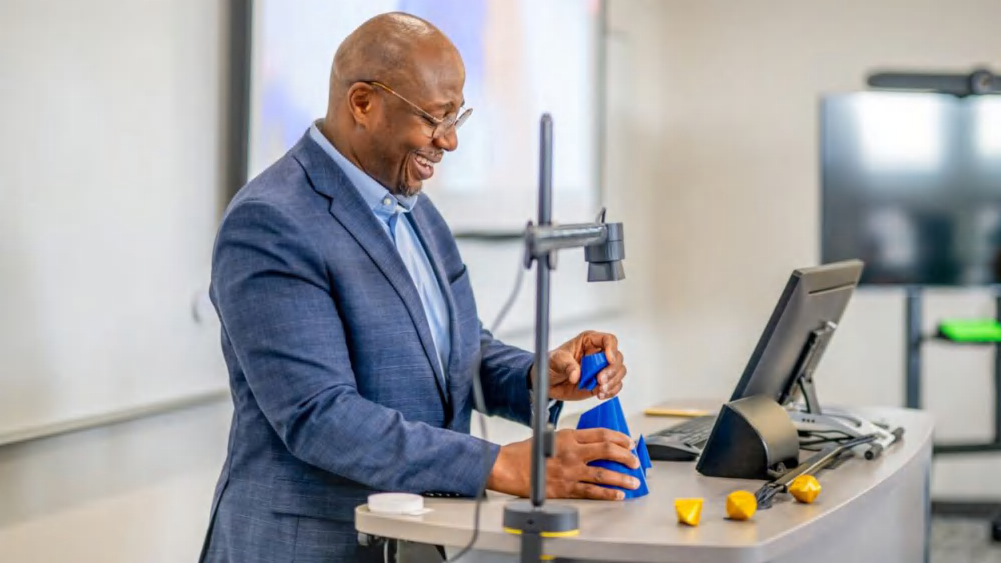What Makes Learning Technology Impactful for Colleges and Universities?

With colleges and universities in the middle of a digital transformation, learning formats are evolving, although perhaps not as quickly as they could. 82% of students now prefer at least some form of online learning, yet 30% of higher ed institutions don’t offer online courses, a number expected to drop by half by 2025. Online or hyflex courses, though new to some, come with high teaching and learning experience expectations.
To lead in a tech-centric world, higher ed IT and tech leaders must provide solutions that enable effective teaching and learning through clear audio and video, and are so user-friendly, they seem to "just work.” IT departments that deploy easy-to-use yet powerful tools will achieve much greater impact for both students and the institution, everywhere from labs to lecture halls, to libraries and beyond.
How Tech Provides Impact
Impactful tech collects admirers, not dust. It can give a professor video-sharing ability at the touch of a button, allow remote students to observe a lab experiment, help someone in a common area hear a lecture clearly, or promote collaboration in a hyflex graduate seminar. Through ease of use and versatility, the right technology provides everyday impact for colleges and universities in many ways, places, and moments.
Faculty Adoption
Choosing well-crafted solutions encourages faculty to adopt them. Regardless of modality, 99.8% of professors prefer to make one or more course components available digitally. That suggests that if teaching a hybrid or hyflex course were as easy and valuable for students as putting a syllabus online, professors would gladly do it. Plug-and-play tech gives institutions better results for their investment by creating ease and enjoyment, reducing troubleshooting, and offering more flexibility in course design and curriculum.
Student Satisfaction
Students allowed to choose between course formats report much higher satisfaction with their courses. Higher student satisfaction bolsters institutions’ reputations and promotes alumni support in the long term. Remote and asynchronous course structures are especially great for students with jobs, family responsibilities, or health challenges. Institutions striving to meet today’s students’ needs and bolster their reputations can use high-quality whiteboard cameras, video conferencing systems, and software to make the online experience just as smooth, immersive, and intuitive as learning in-person.
Maximizing Tech’s Impact by Gathering Feedback

To ensure they get the most out of their investments, colleges and universities should investigate what students and faculty need, and find solutions to match. Find out how faculty are using technology now, what they like about their current setups, and what they wish they could do. For example, if a professor tends to write on their whiteboard a lot, remote students can’t see what’s happening in class for minutes at a time. A solution like the Logitech Scribe Whiteboard Camera with its AI-powered transparency effect, avoids this problem by allowing students to see “through” the presenter for an unobstructed view of the whiteboard (and any sticky notes on it) at all times.
When choosing solutions, IT leaders should also consider the institution’s overarching plan for future operations and how technology plays a role. For example, if an institution’s goal is to expand digital learning modalities while continuing to provide high-quality learning and teaching experiences, it will require transforming facilities all across campus. Versatile video conferencing systems like the Logitech Rally Bar family fit the smallest huddle room all the way up to the biggest lecture hall, with design features for simple deployment and advanced video and audio capability to ensure everyone is clearly seen and heard.
Ongoing Implementation Tips
Adopting technology on campus is only the beginning. The easier it is for colleges and universities to manage their inventory in the long term, the less work and cost they’ll take on after the initial investment. With 33% of educators refraining from teaching with technology because they find it unreliable, user-centered software such as Logitech Sync can help ensure no device is left behind. Sync allows IT staff to remotely adjust settings on linked video conferencing devices, troubleshoot, and push firmware updates, keeping every professor’s remote learning setup healthy, secure, and up to date. It also provides usage data, so IT can make deployment decisions based on how faculty and students engage with solutions. Impactful tech not only works well but continues working by automating maintenance and diagnostics.
Finally, higher ed IT and technology leaders should look for tools shaped with extensive feedback from the people using them to teach or learn. That way, instructors won’t have to wrangle an advanced system, and students will get the learning experience they expect. At Logitech, we build education solutions by gathering feedback from end-users in the beginning, middle, and end of the design process, to ensure the final product effortlessly enables high-quality teaching and learning.
Learning is transforming, but colleges and universities should feel optimistic about the change. Good solutions have the power to boost impact at the student, faculty, and institutional level. With advanced yet easy-to-use technologies putting new learning modalities at the center of how we learn, more students and more institutions will have the chance to thrive in the digital future.
To learn more about Logitech's suite of education solutions, go to www.logitech.com/education.
YOU MAY ALSO BE INTERESTED IN
Let’s Talk
Learn more about how Logitech can help you shape the future of education.
Contact Sales
THANK YOU FOR CONTACTING US
A product expert will reach out to you shortly.